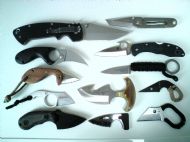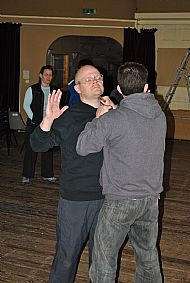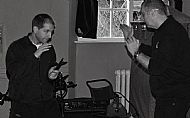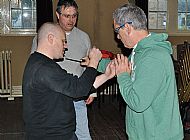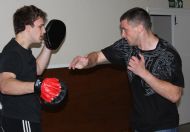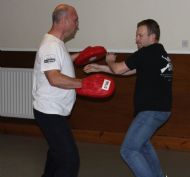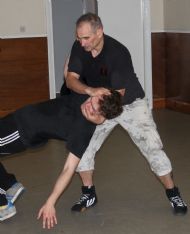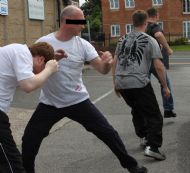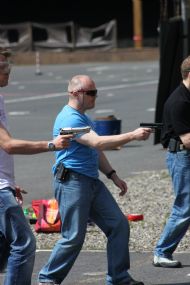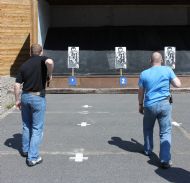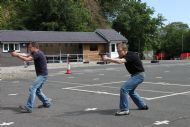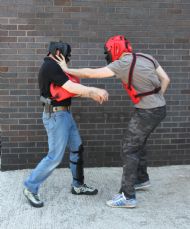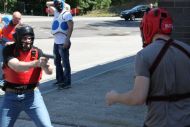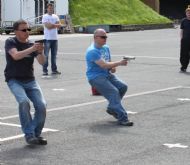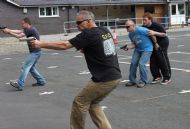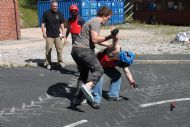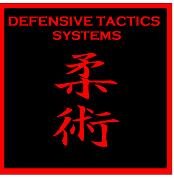 Modern Combatives Group | sitemap | log in Modern Combatives Group | sitemap | log in
|
 |
||||||
| This is a free Spanglefish 1 website. | ||||||
SEMINARS & REVIEWS:STREET KNIFE - EDGED WEAPON AWARENESS AND TACTICS PROGRAM: REVIEW On Saturday the 1st of December 2012 I travelled up to the beautiful Derbyshire district of Chapel en le Frith to run our Street Knife combat program for a local Jui-Jitsu training group.
Andy and Dan are great guy‘s and instructors that always throws themselves into any training with 100% commitment.
This is then followed on by the host club testing out their own counter weapons syllabus against what they have just been shown in the Street Knife session.
This was followed by a series of drills to see what strategies, tactics and ruses an attacker would use to get close to his target before using launching an attack.
This was the section that seemed to hit home to people about just how flimsy, in some cases, traditional knife defence techniques and training can be especially when confronted by a larger, armed and committed attacker.
My final module for the day was on the use of training weapons and how they can be effectively utilised for safe training. I have seen, over the years, an awful lot of bad practices and gimmicks regarding knife/counter knife training. A brief discussion set forth my experiences and what I believe was a comprehensive method of good training practice.
This was then followed up by a series of blade blocking/fending drills, which was subsequently followed by block and strike techniques. All these techniques were trained in a “tactical” scenario – robbery situation, rapid attack.
The combative strikes and takedowns were practiced with full power behind them, thus overwhelming the knife attacker and putting him out of action. The Street Knife section had shown the group that overly complicated and “horse and Pony” techniques just don’t work – no matter how much delusional instructors might want them to. There was no twisty-wrist stuff, no Hollywood fancy moves – just pure out and out power striking to negate the threat as quickly and effectively as possible.
By the end of Andy’s counter-weapon module everyone was bruised and battered, but at least a bit wiser about how a knifer works on the street and what to do in that lethal eventuality.
Hopefully I’ll be asked back at some point in the future, and it would be my pleasure to go.
MODERN COMBATIVES GROUP
This year’s annual MCG close combat training program was held over a balmy summer’s weekend in mid July and, uniquely, was a 2-day affair. The purpose of this year’s training day was the study of close protection skills.
This covers the wide spectrum from protective concepts, walking drills through to hand to hand combat techniques and close range weapons work.
DAY 1: CLOSE PROTECTION
After a brew and a chat we got down to a brief talk that covered the basic principles of close protection work and how that core could be easily transferred over to civilian 3rd party protection should the need arise. For the civilian we would class it as intervening in an attack against a loved one or possibly even a member of the public being attacked, for the CP operator we would class it as an attack upon our principal in any number of environments.
It is my belief that a “warm up” should reflect the type of training that you are running on that occasion, and should certainly have a combative element to it. The VIP Escape warm up was the perfect start to get everybody loosened up and ready for striking work whilst being encumbered by a body.
This section was the core of the combative module and introduced open hand, elbows, knees and kicks into mix, and also included the use of covert strikes to provide a low profile technique to deal with an overt threat.
These methods blended nicely into Rob S’s module on takedowns, throws and control and restraint (C&R) for the CPO where an aggressor has to be stunned, taken to the floor and then restrained or dealt with using a higher force level.
In a CP role not every potential threat has to be eliminated using lethal force, more than likely it will be a less lethal option on the use of force spectrum that will be utilised. It was a fantastic module and was enjoyed by all.
The counter-knife section was interesting as we also got to have a “play” with the Shockknife training tool – everybody had it tested on them, and I can confirm that it really is liked being sliced!! An invaluable piece of kit for counter weapons work.
This included recce’ing the venues, choosing the vehicles, driving the routes, arranging the team and finally briefing the VIP.
The first attack was a scenario where an industrialist was attacked by a “mob” of disgruntled former employees (one armed with a knife).
The other ran to a similar theme but this time consisted of a potential chemical weapon attack!
DAY 2: CLOSE QUARTER COMBATIVE PISTOL SHOOTING
An early start……grab some breakfast. Grab the kit. Wait for the vehicles to get us to the RV point! Drive! Phew….
I think it’s fair to say that the summer of 2012 isn’t going to be best known for its weather, but the Gods must have been looking kindly on us, as it turned out to be a glorious hot summers day (we all went home with tans!). After an orientation walkthrough around the facility by our hosts, we sat down for a brew and to discuss the agenda for the day. This covered the syllabus outline, safety procedures and general housekeeping (weapons, ammo, training equipment, etc, etc).
We began with the basic principle of what exactly point shooting was? Ever since man first picked up a rock and threw it at his prey he has, in effect, been an exponent of point and shoot. We then covered the application of point shooting during combat operations during WW1 and WW2 right up to post-war Special Forces applications.
As this point shooting lecture was meant to be about a progressive system, we discussed how certain UK military units had taken the original applications and evolved them for their own unique remits and theatres of operations.
Several drills and many magazines later, the PS method was becoming second nature to the team – and this was being borne out by consistent shots to the centre of mass on the targets.
After running through some basic strike and draw drills – defensive stance, hit, draw, assess, shoot/no shoot – we turned our attention to the “good guy” getting of the “X” as quickly as possible whilst under threat or physical assault.
For the next module we had to move in doors, more specifically to a state of the art close quarter battle/killing house. Here the team would enter the building one by one, find the appropriate room and engage the targets that presented themselves as a threat. First in a covert method of entry, and finally in a “crash and bash” room storming with all guns a blazing. We threw everything at them – noise/sound effects, flashing lights/dark rooms and general encumbrance during the method of entry phase.
The PES drills included advancing at speed, again laying down covering fire so that the BG could evacuate the VIP, as well as having to draw inside a crowd situation and move the innocent passers-by aside in order to neutralise the threat.
The final piece of the day consisted of one of the team being put through his paces for a DTS grading. It was a tough old battle test and he acquitted himself superbly when faced by the rest of the team that he had to fight. Everybody was battered, bruised and bloody by the end. Fantastic!
As with most of these training days, time is an enemy and we unfortunately had to drop one or two modules to fit everything in comfortably. Ah, well….maybe we’ll finish them off next time……so with a final check to make sure no “brass” casings had made it into our vehicles tyres we headed off home (somewhat bruised and battered, but in good spirits) after what had been a full and varied weekend’s training.
And that isn’t by accident. Everybody gelled together as a team, everybody got on and everybody worked hard, each bringing their own specialised knowledge and experience to the table. What more could be asked for.
MODERN COMBATIVES WORKSHOP AT CHESTER DEFENSIVE TACTICS SYSTEMS - JANUARY 2012
In mid January I was invited to be the Guest Instructor at Chester University’s Defensive Tactics Systems based within the Chester Uni campus.
The club is run by Sensei Robert Stenhouse, a recognised Jiu-jitsu, defensive tactics instructor and serving police officer.
Sensei Stenhouse and I had been in touch over recent months about having a cross training session and the New Year was the first opportunity available for a “catch up.”
After a brief introduction about the MCG and my background, we got down to the business at hand, namely – combatives for civilian self protection. The point of the session was to highlight the need for evolution from the core WW2 based close combat and how we can apply certain techniques for a modern combative environment.
This included a definition of the various combative ranges, the limitations and unique specifications of Fairbairn’s wartime system (and how we could adapt them for civilian SP), as well as the need for an aggressive combative attitude when dealing with a violent attacker!
The techniques that I chose for this introductory session are what we at the Modern Combatives Group term “The Big 3.” They are the Tiger Claw, Chin Jab and Hammerfist. This was supplemented with a range of low destructive kicks that complimented the “Big 3” perfectly. After working hard and putting the team through the nuts and bolts of the techniques, we ramped up the pressure with a range of scenario and stress applications which included combination of striking/kicking techniques, restrictive environment striking, escapes, takedowns and multiple attacker drills. As ever with these things time is always the enemy and the session had to draw to a close…. I have to say I enjoyed working with the DTS team immensely and a more welcoming, enthusiastic and hard working bunch of young people you’d be hard pressed to find. They did their Sensei proud with their positive attitude and the way they conducted themselves. Excellent. Hopefully they took something from the small amount from the MCG syllabus and I would be more than delighted to go back at sometime in the future and work with Chester DTS again.
So a big thanks to Rob for inviting me up and to all the guys and girls for making me feel at home.
MODERN COMBATIVES GROUP: 2011 Close Combat Training Day – Review.
It was a bright cold Saturday morning that greeted us at the start of the MCG “Do or Die” Annual Close Combat Training day.
The “unofficial” training day had actually started the previous night when a couple of like minded combatives practitioners had gotten together over a few drinks to watch and discuss the W.E. Fairbairn Gutterfighting DVD, swop war stories and show off their latest acquisitions that had been gathered over the previous months. A great night with great company.
But the Saturday was all about hard work.
The obligatory catching up with old comrades and the introduction of one or two new ones over a quick coffee came first and then it was straight into getting the heart racing and blood pumping around the body.
GET TOUGH: THE WARM-UP
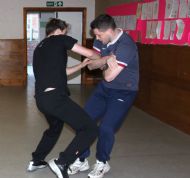
It’s always been our rule of thumb that the warm-up of a training day should have a “combative element” to it. By that I mean there should be a physicality to it rather than just a solo operator doing press ups, sit ups, etc, etc. We are after all combatives practitioners and our training – even a warm up – should reflect that to the full. In our opinion the warm up should be a “short sharp shock” to stretch out all the muscle groups as well as being a cardio assault course.
UNARMED: REACTION – TARGETING –RECOVERY
The unarmed module was geared towards the application of speedy reaction, effective targeting of knockout zones, and rapid recovery from an assault (and countering the threat through focused intensity).
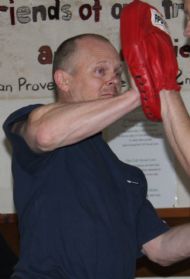
We started the reaction section with the line from the 1943 Arwrology book (and recently brought to light in the excellent American Arwrology by Fred Bauer) with the principle that “If anyone can see what your doing…your doing it too slowly.”
What followed was a series of (speed x power) applications of pre-emptive striking work, with training partners constantly increasing the speed/power to outdo their opponent. This set then incorporated the methods we use for “feeding the machine” of looking for – and finding – the optimum striking targets as quickly as possible.
And so with gum shields firmly in place – we moved onto the final part. Recovery.
What is it?
Well an attack is launched at you – either by being blindsided or by him pre-empting YOUR pre-emptive and you have to both recover from the initial assault, create space and then launch a MORE aggressive and successful counter attack.
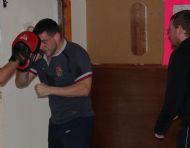
We also broke down the various elements of the WW2 methods of combatives and analysed how they could be adapted and improved for modern combatives training.
CQB ROOM COMBAT TACTICS AND PRINCIPLES
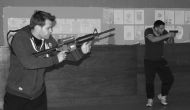
We are lucky to have had at the MCG over the years several experienced firearms instructors and practitioners, and with the team all working together offering their experiences and knowledge, we looked at a broad spectrum of methods of close quarter firearms work; from the operational planning stage, to kit, to entry method tactics and finally culminating in the “Crack House Raid” Action Drill.
This wasn’t just about having a blast shooting the training weapons – fun as it was – this was more about the practicalities of planning and working together as a small unit.
A huge thank you to “Big Jeff” for being our hostage at such short notice.
EXPEDIENT AND IMPACT WEAPONS
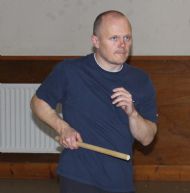
XPD weapon and stick/baton methods is something that we have looked at on many occasions, but because we had several new people attending it gave us an excuse to return to the basic principles and tactics in relation to applying “weapons of opportunity” in a combative situation. We also had the opportunity to look at the various WW2 methods as used by the likes of SOE and the USMC.
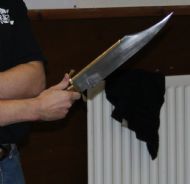
This also included a section on use of “Big Blades” as a fighting tool – Smatchet, Bowie, Machete, Navaja, Bolo, or hatchet – for situations relating to a possible rural or combat environment.
RESTRICTIVE ENVIRONMENT STRIKING
This was a subject that we had covered in depth last year during our “Vehicle Combatives” module where we looked at the realty of fighting inside or around a vehicle where space may be at a premium, but you still have to be able to pound the attacker into the floor (or even out of the vehicle and onto the street)!
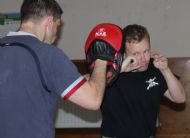
This time we geared the training towards a variety of positions that may be found in a physical confrontation in a social setting – pushed up against a wall, seated, kneeling – and by utilising the skills of deception, pre-emption and power at these ranges.
COUNTER WEAPON DISARMS
After checking the training weapons we turned to the often contentious issue of counter-weapons, specifically in this case – counter handgun.
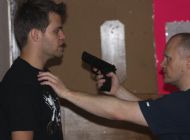
Working on the basic principles of REACT – AVOID – COUNTER - TAKEDOWN, we worked on a range of situations where you’ve been “bumped” and have to fight your way out of a close range pistol attack. Neck, front/low, execution, rear were all added to the mix.
One MCG attendee once told us that as a former member of an intelligence unit operating in Northern Ireland during the 1980’s, his team had to train pistol disarms using blank rounds, which certainly gives a certain amount of “aliveness” to the training – could you imagine Health and Safety signing up for that nowadays!!!
MULTIPLE ATTACKER SCENARIOS:
The day finished off with a return to the unarmed element that we had started that very morning, once again looking at speed, power and targeting, except this time it was integrated with the tactics for dealing with “mob” or multiple attackers.
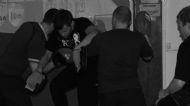
A series of scenarios was wheeled out using an escalating level of threat with each time a new “dynamic” being thrown into the mix such as time restraints, the numbers, or weapons.
CONCLUSION:
This years MCG Close Combat Day did in my (not so) humble opinion top last years. Why? Well its all about the people and the topics.
In a sense the topics are all ready there and have been for many a good year – nothing drastically new has been invented, but many things have been re-invented or given a new “buzzword” for people who want to sell DVD box-sets, Instructor Certificates, etc, etc…….
Thankfully that’s not our way of doing things.
As Bob Kasper stated regarding combatives, “In a sense all the hard work has already been done.” Our close combat/fighting/combative forefathers (whoever you may choose to nominate) have been there and done that….all that the modern exponents are doing is to see if we can become that little bit cleverer, faster, stronger, and more powerful.
So topics and techniques covered. What about the practitioners?
The MCG as an organisation has always stood on its own two feet and looking back (and in a very Darwinian sense) the group would have either ceased to exist virtually straight away or survived and flourished.
I’m proud to say that since early 1999 we have survived and grown and we’ve managed to do this without selling out/brown-nosing to whichever “RBSD guru” is flavour of the month at that moment or by forming temporary “expedient” alliances in order to get the cash-registers ringing. I would rather disband the group than go down that route.....
The reason behind its continued existence are the people that make it a pleasure to be a part of. I think that it’s fair to say that our training hut is NEVER going to be packed to the rafters –we prefer to “cap” the number of attendees, and it’s a strategy that has paid dividends over many years. It provides a clearer and more concise learning experience for all those involved.
We have people travelling from all across the UK in order to spend the day training in combatives with us. That alone tells you something about the levels of commitment, passion and professionalism of the people attending…..conversely it also speaks volumes about people in the past that couldn’t be bothered to travel from 5 minutes away to train…..obviously not made of the right stuff.
So, a big thanks to the “Tech Team” for all their help with the CQB pyros, photos and videoing for the day (which makes an invaluable training aide for assessing were people went wrong/right at the end of day de-brief).
And a final word to the MCG lads – gentlemen, the pleasure was – and always has been – mine.
Copyright – MCG – 2011
WALKING STICK SELF DEFENSE:
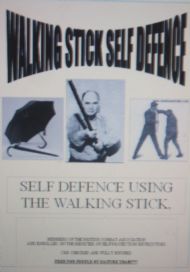
This Easter I was invited to give a series of afternoon lessons in the skills needed for using an expedient impact weapon for self protection purposes.
This was for a small number of gentleman and one very feisty lady who were of “mature years.” Self protection is just as much an important concern for middle aged and pension year’s citizens as it is for the young and fit. If anything more so.
After covering the basics of our awareness and basic security protocols we moved onto the physical aspects of using the cane or walking stick for self protection.
I believe that each group of students that an instructor takes has a unique and individual need, and as such a competent instructor will tailor specific techniques for their physical and tactical requirements. The trick is not to lose any of the practical methods and therefore a balance has to be struck between what is applicable and what is practical.
The first thing we looked at was the limitations of the wooden cane or stick that is used by the general public and included legal matters, range, strength, and effectiveness.
Much of the techniques used that day came from the WW2 stable of impact weapon instructors such as Fairbairn, Pilkington, Styers and Biddle. After some initial reluctance the group quickly “got into” the improvised use of this walking aid.
A pleasant afternoon – despite the swampy humidity – and some genuinely nice people. I must say a big thanks to “old” Sam for acting as my stooge, and also for the post instruction chat (over tea and biscuits) were he regaled me of his time serving with the Hong Kong and Singapore Police Forces, where ironically he had learned some of the Fairbairn techniques that we had studied that day.
Rather than taking a fee for this training program I asked that the folks made a donation to the Help for Heroes charity.
MODERN COMBATIVES GROUP –
CLOSE QUARTER COMBAT (CQC) TRAINING DAY 2010
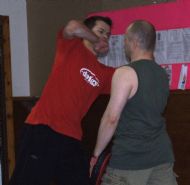
Every year a diverse group of martial artists, combative exponents and self protection practitioners from across the UK gather to attend the Modern Combatives Group annual close combat training day.
The practitioners come from a varied background and over recent years have included BCA instructors, security industry personnel, bodyguard’s, private investigators, ex-military, emergency services personnel, law enforcement, as well as ordinary citizens concerned with their own self protection on the street.
We don’t advertise the MCG training day’s widely. Instead invitation to attend is through word of mouth and recommendation of a fellow MCG member. We run a closed door policy and it is one that has paid off over the years, by keeping the numbers small we offer a more concise learning experience. However, for the right person with the right attitude and commitment we gladly extend a welcoming hand.
The MCG close combat day’s give the attendees the chance to share knowledge, experiences and skills of fighting at close quarters!
This year saw the MCG’s 6th Annual Close Combat training day and took place on Saturday the 7th of August at our usual venue of the “hut” on the Wirral, Merseyside.
One of the fundamental principles of the MCG is that we train, study, practise, and learn to deal with the ever changing and shifting trends of modern day threats. That is its primary goal – to always adapt, evolve and sustain the latest information that threatens our personal protection.
Because its members are active in a wide range of environments that can on occasion bring them into various states of physical conflict, they are always keeping abreast of the latest range of personal and corporate security threats and how they operate in the real world.
That is why the Modern Combatives Group is ALWAYS constantly shifting and adapting to these situations and environments, and fundamentally we owe it to ourselves to train to counter the “next big thing” in personal security threats.
There are many groups (and indeed TMA’s) out there that are still “locked” into a bygone age of WW2 era combatives and don’t (or won’t) develop strategies needed for the modern-age. The Modern Combatives Group recognises that the methodology of “attacks” (and more importantly how to train for them) has changed too over time.
These days you are more than likely to find groups of almost “feral” gangs attacking the unaware, street assaults that consists of taking people to the ground and “pounding them”, armed assaults with all manner of weapons, car-jackings in major cities, and attacks on company employees and staff at various retail environments. Street criminals and their tactics have themselves evolved in to related areas of crime and violence. That is why it is our duty as modern combative exponents to evolve and be as cutting edge as we can be.
When you enter our training hut you are met with all the paraphernalia to go around beating each other up. The musty smelling room is filled with punch bags, focus mitts, shooting targets, impact pads, sticks and a wide range of training knives and test cutting “dummies”. Occasionally if we’re very lucky we’ll even add in some crash mats to soften the blow!
After a brief chance to catch up with old friends (and introduce some new ones) the day started with an assessment of modern day personal security threats and how they can impact on our personal protection planning. As always first we cover the strategy, then we supplement it with the tactics.
Street Smart Personal Security Skills:
This topic looked at multiple target placement shots – the optimum place to strike for the best effect whether that be a KO or to disable an opponent. At the MCG we call this “feeding the machine” (for an overview of this subject there is an article on our web-site) in other words we want to hit high value targets, correctly and as often as possible.
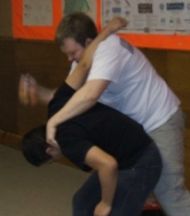
There seems to be a trend at the moment with everyone trying to “micro-manage” power, usually at the detriment of concise and effective targeting of a chosen striking tool. Therefore our methods combine ballistic power striking coupled with accurate shot placement, rather than the “swinging out and hoping it lands” principles that fail to offer a serious forward planning outcome.
We also discussed – and in some cases dismissed – the so called “effectiveness” of certain techniques that have been propagated as 100% proof over recent years. This is something that we have highlighted time and again on corporate training courses that we have run, where people new to self protection are sometimes duped into believing that a certain technique has the magic bullet effect.
Our aim is to give them a quick (and sometimes harsh) reality check, but also for them to question and test out each and every technique to see if it stands the test of resistance, pressure and effectiveness. Every person engaged in combative training has a duty to themselves to NOT take at face value the merits of a chosen technique just because “its always been that way.” Only dead fish go with the flow, and if the technique and its application don’t pass muster then it should be relegated to the trash can.
Street Boxing and Grappling:
The “Feeding the Machine” tutorial culminated in a series of practical street boxing, open hand combative striking and close range grappling drills designed to present constant pressure to an attacker and take him out of the game ASAP. As ever we looked at the elements of STRIKING TOOLS - POWER – FOOTWORK - TARGETING to build on the combative tactics building blocks.
The final combat boxing stress drill was designed to make everybody go weak at the knees and have them sucking in gulps of air by the end of it all. I’m happy to say it achieved its desired result and no one collapsed (although there were a few close calls). It loosened everybody up nicely and got them in the right frame of mind for what was to come.
Rapid Action Takedowns/Defensive Tactics:
We then moved onto various skills and tactics required for rapid action takedowns, this was particularly relevant as a percentage of our group have worked in various roles in front-line security – from dealing with members of the public, doorman, retail security through to close protection operators – and the need to take an aggressor out of the picture rapidly is sometimes more preferable than impact striking.
R.A.T.’s are a lower force option than straight in power shots and present the operator with a less lethal option which can be “upgraded” to more extreme violence as and when the situation requires it.
This module was one of the high-lights of the day as it gave the participants the chance to share knowledge about how to get the best from the techniques, as well as offering real time experience from those that had performed them in extreme circumstances.
The takedown section ended with impact weapon defensive tactics for those who might on occasion have to work with the tactical baton/ASP, etc. Great fun and lots of hard work as we introduced takedowns, chokes and locks into the equation. By the end of the module there were more than a few swollen throats and aching ribs!
Multiple Attackers and Team Tactics:
One of our long time members Andy G took the next module on dealing with multiple attackers and team tactics. Although we have covered multiple attacker training many times over the years, Andy’s module was one I personally was looking forward too with relish.
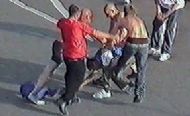
It seems blatantly obvious that “bad guys” like to learn and adapt too, and in a very real sense we are, as self protection practitioners, always playing “tactical catch-up” to the latest gang strategy or street tactic. They develop a skill, we have to discover how to counter it, and so on and so forth.
Andy laid down the basic strategy of dealing with a multiple or mob attacks, namely that it’s a very scary worst case scenario with no easy solution, and if you can’t get out of there double quick you don’t want to fight a gang all at once, but rather one at a time in a linear route. Hit and move, hit and move was the order of the day and one that pays dividends when you have adversaries coming at you from the front, side, behind and those blindsiding you.
This module included a wide range of physically draining stress drills of having to deal with overwhelming force by means of deception, body positioning, pre-emption, and at time pure naked aggression and force that puts the attackers on the back foot giving you enough time to “blast” through their barrier. A great module that everybody got something from and one we’ll definitely be re-visiting at a future seminar.
Knife Combatives:
The morning ended with a follow on from last year’s training, namely the second module of our knife combatives program. This time utilising the defensive applications of edged weapon usage which included blade fending and counter-cutting, as well as various drills introducing an edged weapon in a close range grappling situation.
As ever with close range knife work we work from a realistic and practical application, rather than going through a range of “martial arts” drills, and this is usually borne out by the wide range of bruises on show at the end of the pressure drills.
Close Combat Concealed Pistol Skills:
The CCCP was the module that everyone was eager to get stuck into, and one that was to take up the rest of the day!
We are fortunate to have had over the years at the MCG several experienced firearms practitioners that has enabled us to present a comprehensive and well thought out introduction to the combat pistol.
Several of the guys attending had never had the opportunity to train in any kind of firearms related material, so it gave us the chance to pass on our experiences. In many ways having so many people unfamiliar to pistol work was a plus as they were basically “blank sheets” to start working on and didn’t have to start unlearning bad habits.
We have conducted this shooting program several times overseas – working with live weapons - but obviously because of UK firearms restrictions we utilise high-end air-soft training weapons to get it as close as we can to the real thing. This is vital when running ECQ shooting drills with training partners.
However, our attitude is that we can be as professional as we choose to be, and it was drilled into the people attending that we would take all precautions and have the proper respect for the weapons that we were using as though they were ACTUAL firearms as opposed to training weapons. It’s a good mindset to instil into new people being instructed in pistol work and one that can pay dividends over time.
Starting with the primary skills such as operational roles, mindset, safety, concealed carry options, technical proficiency and ballistics, we then moved the training onto to look at the various stances, draw stroke and shooting positions.
Believing that what grows well grows slowly we took our time to get the guys to an acceptable level before we upped the scale and started introducing “live-fire” shooting drills.
For those that thought that this was going to be a paper target shooting exercise, well they were quickly wised-up. We classify this as “street fighting with handguns” rather just taking pot-shots with no physical interaction involved.
There is a world of difference between shooting at a static paper target and having to deal with (and fire at) a live adversary getting ready to gut you with a knife, and this was borne out in several force on force (FOF) stress drills.
Again everybody learned a lot from the CCCP introduction program and I’m sure its one we will be returning to again and again over the years. We, literally, had a blast!
Vehicle Combatives and Defensive Driving Tactics:
The day finished with a look at the use of combatives whilst operating in or around a vehicle.
I worked out recently that I have spent half of my working adult life operating in and around vehicles during private security and close protection projects to conducting informal “meetings” and running surveillance jobs in a variety of vehicles in a wide range of environments – some unproblematic, some decidedly hostile. Not to mention the amount of driving as part of day to day life from one end of the country to the other or even something as simple as parking in the local supermarket or multi-storey!! Each presents its own individual security issues.
We looked at the operational requirements needed when approaching, entering and/or exiting a stationary vehicle in a potentially hostile environment, namely our situational awareness and personal security protocols. This goes back to our original point of adapting to modern threats and with the spate of car jackings, roadside muggings and robberies this was a relevant topic for the day.
The tutorial was followed by a series of close range power striking drills and applications of weapons skills to remove an attacker from the access points to the vehicle and facilitate an escape.
Thanks for assistance and information on this module must go to “Big” Dave P, who has more practical fighting experience (20 years +) in or around vehicles than many of the “street fighting” RBSD instructors of today.
AT THE END OF THE DAY…..
You won’t find any big name “celebrity” instructors at most MCG training day’s (although we gladly invite guest instructors that we believe have something to offer), no DVD’s, internet downloads, T-shirts, coffee cups, key-rings, etc, for sale or anything of a commercial aspect. It’s just not our kind of thing.
But you will find people that are willing to offer their experiences and knowledge from having been there and done it for real on numerous occasions.
There is ho “hype” surrounding the CQC training days (unlike some that claim to offer the “ultimate” the “best in the UK”, “the best in Europe”, etc, etc) they are what they are - tough, arduous and at times physically and mentally exhausting instructional programs that provide relevant information on a specific subject matter, but can tend to leave participants with a wide range of bumps, bruises, cuts, welts and the occasional black eye. It’s a beast of a day, that is all about the learning of new skills.
“You get out what you put in” is a phrase that I use on many occasions during instructional training. And its very true.
However it was pointed out to me recently, by some wit that had viewed some of our training material that “if that’s what you fellas do to guys you like, imagine what you’d do to people that you DON’T like.” Fair point.
The physicality of the training session is probably best summed up by one of our lads who contacted me the next day to say that he “didn’t remember being in a car crash” on the Saturday, but he obviously had the duelling scars and aches to remind him.
If the above statement doesn’t phase you at all – well, then you sound like our type of person! Get in touch!
Fundamentally you can forget all the techniques, tools, methodology and experience of its members, etc, etc, the day’s greatest attribute is the ability of the people to work together as a unit with support, professionalism, good humour and an unending quest for knowledge and to share information about a chosen subject matter.
In short the MCG training days are a success which can be summed up by one simple phrase;
Teamwork.
So a big thanks to all the team for making the day a success and making it so enjoyable.
Also a warm welcome to our newest “honorary” combative team member – Mike B – who it seems can handle a Glock as well as he can handle a video camera and a Nikon!
The lads are already starting to plan out the next “bash & slash” day (how’s that for keen). I can’t wait, roll on 2011…..
The Modern Combatives Group was established in 2002 and regularly trains both civilian and specialist security personnel in self protection, close quarter combatives and personal weapons skills.
For further information please email: mcguk@live.co.uk
Promo Video available:
Copyright – MCG – August 2010
MODERN COMBATIVES GROUP: 2009 Annual Gutterfighting Close Combat Day
Saturday the 8th of August 2009 saw the Modern Combatives Group’s annual “Gutterfighting” close combat training day.
The training day was an “invitation only” affair which saw practitioners of modern combatives travel from all over the UK. The annual “bash & slash” day provides the MCG with a chance to get together and train in a wide range of close combat related skills.
Hard work is the order of the day, and with one of the hottest days of the year so far, the 2009 day was no exception.
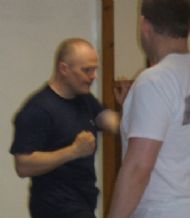
The lads covered everything from pre-fight/in-fight concepts; street based bare knuckle fist-fighting, WW2 combatives, Fairbairn’s Defendu/SMP Police C&R techniques, counter-weapons, to knife combat/edged weapon and impact weapon/stick combat.
It also gave us the opportunity to dispel some of the combative “myths” propagated by numerous instructors as to how certain close combat skills are applied for “the street.” This isn’t just based on theory, as we are one of the few groups out there whose members use these skills in live situations on a regular basis.
Overall a first rate day with a great bunch of like minded individuals who provided hard work, tenacity and humour to make the day truly exceptional. As usual the end of day finished with much swapping of material, kit and “toys.”
Congratulations to the “beer run” boys who well and truly earned their prize – hopefully they made it home sober and in one piece. Also a big thanks to James B and Dan W - who are the “rocks” of the MCG – for presenting some fantastic training modules, as well as Richard M our long suffering chronicler/cameraman for all his hard work. The only bad news was that Jimbo was unable to join us (due to being involved in a biking accident), but hopefully he’ll be fully recovered in time for the next one!
A few cuts and bruises along the way, but all good fun and the team are already looking forward to next year’s gathering.
MCG – 2009
CLOSE QUARTER BLADE PROGRAM 2:
The May 2008 CQB program was attended by a four man contingent of guys from the local infantry regiment who'd approached us regarding military based combative training.
EXTREME CLOSE QUARTER COUNTER WEAPONS TRAINING DAY:
The Extreme Close Quarter Counter-Weapons workshop was our last training seminar for (a busy) 2007, and focused on the very real and in your face world of counter weapons.
For the afternoon session we again detailed the tactics and types of response to various street weapon attacks - which ranged from stick, impact weapons, expedient/improvised right up to the use of various types of firearms - and more importantly how we should deal with them from a self protection point of view.
DEFENSIVE SECURITY TACTICS:
ECQ COMBATIVE HANDGUN - AUGUST 2006
The Modern Combatives Group are a UK based security training group that specialise in close protection and covert surveillance, along with many other facets.
One of these facets includes corporate and personal security training. After an exhaustive web-search on UK based handgun retention training, I eventually came across MCG via some links given to me from some pals in the ol' US of A. I fired off an email and waited for a reply. After the first reply I built up quite a rapport with David Armstrong and arranged to attend his Extreme Close Quarter Combat (ECQC) Handgun seminar on the 5th August 2006.
This seminar is primarily aimed at Police, Military and Close Protection personnel; generally folk that is likely to have a gun pointed at them!!
The ECQC Handgun seminar is just one module in a five module modern combatives series of seminars run by MCG, aimed at providing effective and retainable combative self protection skills for street situations.
As for me, an ECQC handgun course is another "tool" for my "toolbox" and involved driving up the 250 miles to Wirral, Merseyside from Croydon, Surrey the night before and staying over in a B&B. I found their training centre easily the following morning due to the directions and many maps provided in the pre-course pack.
Throughout the day techniques were broken down into their most basic forms and demonstrated (sometimes painfully) by James, one of the senior instructors. This allowed us to perform them slowly at first and build up to speed before introducing "live" attackers.
Skill sets covered included, safe firearm handling, point shooting, retention drills, counter-retention drills, learning combat speed rock, combative strikes, stress drills, force on force training, multi attacker scenarios, firearm assaults, low-light killing house, disarming a third party, and although it wasn't supposed to be included, the guys also ran me through some knife drills.
ECQ COMBATIVE HANDGUN #2
Following on from the previous seminar review, we conducted several more private classes of the Extreme Close Quarter Combat Handgun program, including an invitation down to Southampton to run a session with some suitably qualified participants, this finally culminated in early September 2006 with the training of a private security team at a "closed" facility in the Nerja region of Spain.
VIPER PROGRAM - WOMEN'S SELF PROTECTION: This was our first "civilian" VIPER Program that we had conducted over recent years. The majority of women's self protection training that we have been approached to organise has been of a corporate nature. So it was nice to giving something back to the people who really required self protection - the everyday local person. The May 2007 program was a strictly non-profit making project and was run purely to raise awareness amongst local women on the Wirral about personal safety and self protection. With a compact but diverse group to train ranging from teachers, to party organisers, to businesswomen, it was back to basics with all the usual self protection concepts of awareness, evaluation and avoidance being covered as well as a range of role specific security situations being discussed.
The afternoon section started with an overview of edged weapon awareness and aimed to dispel the myths that surround surviving a knife attack. We then moved the attendees onto our "Doomsday" drills - that in your face close up and personal scenario of knife assaults. |  |
|||||
 | ||||||
